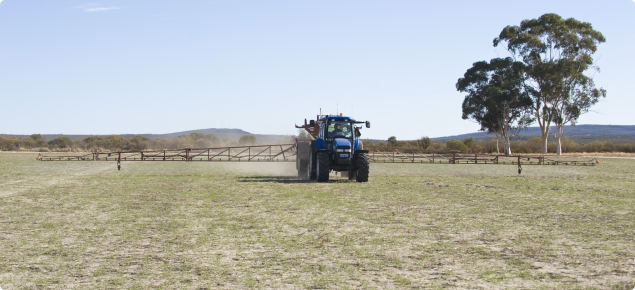Spray-topping
‘Spray-topping’ consists of spraying pastures in spring, before most weeds have set viable seeds, in preparation for next year’s crops and pastures. Weeds that flower over a short period of time make better targets for ‘spray-topping’ than those that flower over several weeks. Good control of weeds that flower over a long period may require more than one herbicide application. ‘Spray-topping’ treatment is particularly suitable for grasses.
For ‘spray-topping’ to be effective:
- graze paddocks heavily, to prevent early seed head formation
- remove stock two to three weeks before normal flowering time, to allow even regrowth. This encourages weeds to all flower at the same time.
Apply herbicides:
- glyphosate should be applied when grasses are flowering (see table below)
- Gramoxone® may be applied from flowering to the milky dough stage but before there are signs of haying off
- a couple of days after spraying, graze the paddock. Sheep are as important after spraying, as before. They graze seed heads that may emerge following spraying.
Glyphosate at 240-450mL/ha (depending on formulation), Gramoxone® at 500mL/ha and Spray.Seed® at 800mL/ha were all registered for seed set control at the time of publication of this document. Oils and wetters may also be added. See product labels for full details.
When spraying, the height of the boom should be set to ensure a double overlap of nozzle patterns at the height of the grass canopy. Apply in 60-150L/ha of water to give good coverage.
Pasture legumes (clover and medic) are also highly susceptible during flowering. ‘Spray-topping’ may suppress legume seed set if they are flowering.
Where the soil weed seed bank is low, ‘spray-topping’ may reduce substantially the need for weed control in a following cereal crop.
Research on the technique to wipe chemicals such as glyphosate and Gramoxone ® using the blanket wipers has shown excellent results (see Herbicide application and Herbicide application for declared plants links).
The phenoxy herbicides can be damaging to sensitive crops such as vines, tomatoes, canola and legumes. For this reason there is currently legislation in place to protect vine and tomato crops (see Herbicide application legal aspects link).
|
Treatment | Growth stage when herbicide applied |
Seed yield kg/ha |
Viability |
| Nil | n/a | 1170 | 90.6 |
| Glyphosate (450g/L) at 360mL/ha
| Booting (head still encased in leaf sheath just prior to its emergence) | 410 | 85.3 |
| Head emergence
| 290 | 87.0 | |
| Flowering
| 90 | 59.0 |
Further information
Further information on controlling declared plants can be found through the Declared plant control handbook link.
Other topics that may interest you include:

